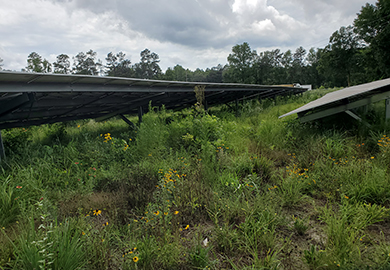SCDNR News
Santee Cooper’s Jamison Solar Site becomes First Gold Certified Solar Habitat
Your site can be gold too – Solar Habitat Certification Deadline approaching
ORANGEBURG COUNTY, S.C.
December 21, 2021

Santee Cooper's Jamison Solar Site, a 1.2-megawatt facility located on 5.4 acres near the I-26 and Hwy 601 interchange in Orangeburg, has become South Carolinas first Gold Certified Solar Habitat site.
"We are pleased that Jamison Solar Farm is the first Gold Certified Solar Habitat in the state and even more pleased to help lead the way to more certified solar habitats across South Carolina," said Chief Power Supply Officer Marty Watson. "Creating this habitat for pollinators is just one way Santee Cooper puts environmental stewardship into action, and we couldn’t have accomplished it without the help and guidance of the team at SCDNR."
To become Gold Certified Solar Habitat, Santee Cooper had to commit to planting a diversity of native flowering plants underneath and around the site's 4,482 solar panels. The planting of native pollinator plant species aids in reducing soil erosion, protecting water quality and enhances the aesthetic beauty of a solar site in addition to the ecological value it provides for pollinators such as bees, butterflies, moths, birds and more.
Under the authority of the Solar Habitat Act, which was signed into law by Governor Henry McMaster in 2018, the South Carolina Department of Natural Resources (SCDNR) established "Technical Guidance for the Development of Wildlife and Pollinator Habitat at Solar Farms" and working with Clemson’s Department of Fertilizer Regulation and Certification Services developed the S.C. Certified Solar Habitat Program.
"Conservation often requires us to think creatively to support species and their habitats while also allowing for human use and the Solar Habitat concept does just that," said Robert Boyles, Director of SCDNR. "People need power, but we also need the pollinators too."
The South Carolina Solar Habitat Act (S.C. Code of Laws §50-4-10) provides a voluntary framework to encourage owners of ground-mounted commercial solar energy generation sites to follow voluntary site management practices that:
- Provide native perennial vegetation and foraging habitats beneficial to gamebirds, songbirds and pollinators; and
- Reduce stormwater runoff and erosion at the solar generation site.
A self-paced online training is available for landowners, solar developers, utilities, county planners, zoning administrators and others who are interested in solar habitat development. To explore the online training, please visit www.dnr.sc.gov/solar.
Applications for enrolling a solar site in the program are due Jan. 15, 2022. The Application Fee is $200 and there is a per acre fee as well. For additional information regarding the fees, visit https://www.clemson.edu/public/regulatory/fert-seed/solar/index.html or contact Ezra Munn, with the Department of Fertilizer Regulatory and Certification Services at 864-646-2147.
All the information regarding the S.C. Solar Habitat Program may be found online at www.dnr.sc.gov/solar.



